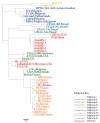Genealogy of an in-vivo passaged isolate of western Canadian bovine respiratory syncytial virus
- PMID: 35794977
- PMCID: PMC9251804
Genealogy of an in-vivo passaged isolate of western Canadian bovine respiratory syncytial virus
Abstract
Bovine respiratory syncytial virus (BRSV) is a primary respiratory pathogen in calves. Clinical infection with this pathogen has been experimentally modelled to assess vaccine efficacy using a field isolate (Asquith) of BRSV that has been sequentially passaged in vivo in neonatal calves to maintain virulence. The objective of this retrospective cumulative analysis of passages over approximately 20 years was to determine if there have been any changes in the viral genome of this isolate because of this process. Sequence analyses indicated that the Asquith isolate placed genetically in a clade comprising US and some European isolates and a recently described Chinese BRSV isolate (DQ). Furthermore, there were rare changes in bases over time in the N, G, and F gene segments examined when comparing among different passages ranging from 1996 to 2019. These results indicated the absence of significant mutations in the absence of significant adaptive immunological pressure.
Le virus respiratoire syncitial bovin (BRSV) est un agent pathogène respiratoire primaire chez les veaux. Une infection clinique avec cet agent pathogène a été expérimentalement modélisée pour évaluer l’efficacité vaccinale en utilisant un isolat de champ (Asquith) de BRSV qui a été passé séquentiellement in vivo chez des veaux nouveau-nés pour maintenir sa virulence. L’objectif de cette analyse rétrospective cumulative des passages sur une période d’approximativement 20 ans était de déterminer s’il y avait eu des changements dans le génome viral de cet isolat à cause de ce processus. L’analyse des séquences indiquaient que l’isolat Asquith se positionnait génétiquement dans un clade comprenant des isolats américains et quelques isolats européens et un isolat chinois de BRSV récemment décrit (DQ). Également, il y avait de rares changements de bases dans le temps dans les segments de gènes N, G et F examinés lors de la comparaison parmi les différents passages allant de 1996 à 2019. Ces résultats indiquent l’absence de mutation significative en absence de pression immunologique adaptative significative.(Traduit par Docteur Serge Messier).
Copyright and/or publishing rights held by the Canadian Veterinary Medical Association.
Figures



References
-
- Ellis J. Bovine respiratory syncytial virus. In: Munir M, editor. Mononegavirales of Veterinary Importance. Pathobiology and Molecular Diagnosis. Vol. 1. Wallingford, UK: CABI Publishing; 2013. pp. 170–184.
-
- West K, Petrie L, Haines DM, et al. The effect of formalin-inactivated vaccine on respiratory disease associated with bovine respiratory syncytial virus infection in calves. Vaccine. 1999;17:809–820. - PubMed
-
- Ellis JA. How efficacious are vaccines against bovine respiratory syncytial virus in cattle? Vet Microbiol. 2017;206:59–68. - PubMed
MeSH terms
LinkOut - more resources
Full Text Sources
Medical
